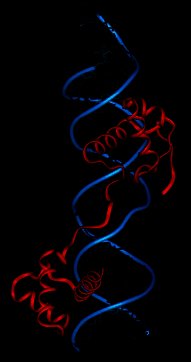NCBI Bookshelf. A service of the National Library of Medicine, National Institutes of Health.
Dean L, McEntyre J, editors. Coffee Break: Tutorials for NCBI Tools [Internet]. Bethesda (MD): National Center for Biotechnology Information (US); 1999-.
The Pax6 group of genes belongs to a larger class of homeobox-containing genes, found in organisms from yeast to humans. They code for transcription factors and are distinguished by the presence of a specific DNA-binding motif (a homeodomain) that serves to regulate gene expression. The "helix-turn-helix" 3D structure of the homeodomain is the same structure that is seen in bacterial gene regulatory proteins, suggesting that this is an ancient conformation that has been conserved throughout billions of years of evolution.
In mice, sea squirts, and squid, Pax6 has been shown to activate the program that leads to eye formation during the development of the organism. In mouse, where the Pax6 gene is expressed in the developing eye and brain, a mutation called Small eye (Sey) results from defects in Pax6. This makes it a good model for studying aniridia, a condition caused by a mutation in human Pax6 in which an incomplete iris can lead to poor vision, light sensitivity, and a tendency to develop progressive glaucoma.
Although the eyes of vertebrates have a single lens, the compound eye of Drosophila consists of about 750 units, each unit containing a lens, retina, and photoreceptor cells. Even so, parallels exist between these two types of eye. In flies, the eye precursor cells differentiate into these distinct units at a distinct step of development, when ey, a Pax6 homolog, can be detected.
Recently, a second Drosophila Pax6 gene was reported and named twin of eyeless (toy). Perhaps surprisingly, toy in some ways is more similar to the evolutionarily distant vertebrate Pax6 proteins than to Ey. In particular, fly Toy and mouse Pax6 have a similar DNA-binding pattern; they have a much higher affinity for DNA than Ey. This can be attributed to the mutation of a single residue (Asn?Gly) in a highly conserved part of Ey, known as the paired domain.
The existence of two Pax6 genes in flies, but not in vertebrates, suggests that a gene duplication event occurred sometime during fly evolution. That Toy is more closely related to vertebrate Pax6 suggests that Toy is the more ancient form, which gave rise to Ey. The key point in the evolution in these two genes was probably when the Asn?Gly mutation occurred, radically altering the DNA-binding function of Ey. At this point Ey could have become dependent on Toy for its activation, triggering a divergence in function of the two proteins. Today, genetic evidence suggests that Toy is found upstream of Ey in the regulatory pathway of eye development, and they each regulate distinct developmental events.
Search PubMed for Pax6 mutations
Created: September 29, 1999
Click on the link below to start an html tutorial.
Find information on Pax6 mutations
Search GeneMap99 for Pax6
Created: September 29, 1999
Click on the link below to start an html tutorial.
Where is Pax6 found in the human genome?
Use BLAST to search for proteins similar to Pax6
Created: September 29, 1999
Click on the link below to start an html tutorial.
See how Drosophila Ey compares to other Pax6 proteins
- The compound eye of flies divulges evolutionary secrets - Coffee BreakThe compound eye of flies divulges evolutionary secrets - Coffee Break
Your browsing activity is empty.
Activity recording is turned off.
See more...

